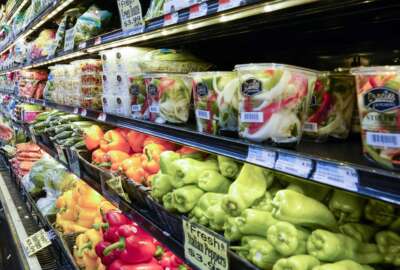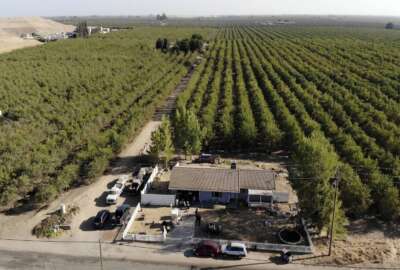USDA modernizes an important research facility with a whole new building
The Agricultural Research Service has broken ground on a big new facility at the University of Kentucky. It's known as the Forage-Animal Production Research Uni...
The Agricultural Research Service has broken ground on a big new facility at the University of Kentucky. It’s known as the Forage-Animal Production Research Unit. For what will happen there, Federal Drive with Tom Temin turns to the ARS Research Leader for forage animals, Michael Flythe.
Interview Transcript:
Tom Temin Well, let’s begin with the big picture of forage animal production research. What is that all about? Forage is animals that we’re going to eat that in turn eat grass?
Michael Flythe Yes, exactly. It’s really all about grass. It’s really all about how do you turn sunlight into something you can use? And plants do that. Plants can take nutrients from the soil and rain and sunlight and turn it into grass. But people, the limited ways in which we can directly utilize grass. But one of those ways is by making use of the animals that can eat it.
Tom Temin So what are the research topics that are top of mind for this? Making grass that’s more efficient in terms of having more nutrients packed in so there’s less forage land needed? I mean, what do you look at in forage research?
Michael Flythe Yeah, absolutely. I like to think of it as as a triangle with the word respect in the middle of it. That’s kind of what sustainability means to me. And so we want a forage animal production systems that respect the land and our natural resources and our soil. And we want it to respect the animal, the evolutionary history of the animal, the animal’s health and the well-being of the animal. And we also want the system to respect the people who do that agriculture, that they can make a living off of it, particularly here in Kentucky, where we’re located. Most forage animal producers are family owned businesses. We have beautiful broodmare farms for our horses. Those are family owned businesses. And then cattlemen and goat producers and sheep producers, very often they have jobs off farm, but they have a small herd of animals that represents their family’s wealth. And so to us, sustainability includes all of those things.
Tom Temin And so the research then centers on what specifics? What’s changed here over 1000 years of goat herding or 10,000 years of goat herding?
Michael Flythe Oh, a lot of improvements have been done. One thing is that animals don’t migrate the way they would in nature, right? So we have to have ways to maintain those animals on our farms in ways that honor and makes use of their evolutionary history of migration. But find a way to do it in a way that it can be done on a farm. And so there are improved forage varieties, proof soil management practices and improved animal management practices. One of the issues that we have that we can face is drought. Here in Kentucky, many, many decades ago they discovered a grass called tall fescue that’s very, very drought resistant. And one of the reasons it’s so drought resistant is because it has fungal endophytes, a fungal partner, a symbiant. It lives inside of the grass and makes it very resistant to pests and very hardy and drought resistant. But the problem is, is it also makes it toxic to the animals. And we didn’t know that until we had spread fescue all over the country. Wow, it’s a great turf grass, but animals have problems related to it. And so one of the things that our unit does is work on solutions to that fescue problem.
Tom Temin So that a grass that can be grown and regrown and regrown in the same place with a minimum of water that can still feed the animals over and over again, basically on a given farm. That’s the big challenge?
Michael Flythe Yes, exactly. And do it in a way that that grass is not susceptible to insect pests and diseases and things like that, but also doesn’t hurt the animal. This one in particular, the fungus makes a toxin that impedes the animal’s blood flow. They can’t get blood out to the extremities, which becomes a problem for heat dissipation. So they can become very, very hot when it’s not hot. And you’ll see them standing in the water or standing under the shade and not eating. And it looks like they just don’t feel very good. So we’ve come up with improved forage varieties that don’t have that toxin, but then also ways to reverse that toxicosis when those animals are sick.
Tom Temin Interesting. We’re speaking with Michael Flythe. He’s research leader for the Forage Animal Production Research Unit, part of the Agricultural Research Service. Now this new center at the University of Kentucky, what is that all about? It’s a huge building that’s under construction. Now. What will happen there?
Michael Flythe It is a partnership between the USDA’s Agricultural Research Service and the University of Kentucky. Our researchers have been on the ground here at University of Kentucky for almost two decades now, but we haven’t really had a home. We’ve been living in University of Kentucky facilities and working with their faculty members who help us with our projects. But we’re spread out all over campus. And so this is going to put us together in one state of the art facility. Tom, one of the key things about science or any time you’re working together with people is having them together in a place where they can collaborate and sharing a coffee pot. So many great scientific ideas come from people standing around the coffee pot. And so you can increase the rate of these happy accidents in science just by having people working together. And so the building is going to be laid out in a way so that university researchers or USDA researchers be side by side when they’re working on the same projects, rather than separated by which institution they work for. We’re going to let the science and we have let the science design drive the design of the building.
Tom Temin And will there be facilities there that a animal can eat in and that you can grow grasses in and this kind of thing? Will there be kinetic type of lab activity there?
Michael Flythe Animal facilities, no. University of Kentucky has several wonderful research firms. Those and our other partners like Kentucky Cattlemen’s Association, they have a research and demonstration farm, too, and the work will continue on those forms. This will mostly be state of the art laboratory facilities, but there will be greenhouses.
Tom Temin All right. By the way, what are the forage animals? I mean, Kentucky horses forage, don’t they? The reason I ask is mostly when you see animals feeding, they’re eating corn out of a trough. And that’s not really foraging, is it?
Michael Flythe No. And that’s that is a very good point. Horses are certainly included in our mission. Cattle are a big part of our mission. Kentucky is the largest cattle producing state east of the Mississippi, and we have the cow herds that provide many of the calves that might go out west later in their life, and small ruminants like sheep and goats.
Tom Temin Right. So what is that whole issue all about then? Because the corn versus grass question is an ecological question. It’s an animal welfare question. It’s a resource question. Where is that all heading, just out of curiosity.
Michael Flythe Very astute, Tom. Yes, absolutely. Corn and other cereal grains are a great way to put calories into an animal. But ruminant animals like cattle and goats, that’s not what they evolved to eat. It’s a much more highly digestible and sometimes it does cause cause health problems for them. And that’s one of the parts of our mission, is finding the best way to finish these animals on forage on a diet that they were evolved to consume.
Tom Temin This is a really in the weeds question, no pun intended, but when they’re eating corn, do they also chew their cud or is that a result of eating forage grass?
Michael Flythe They do, but there is there is a response to having longer stemmed material. You’re talking about ruminants that you their cud down so that they’ll bring up a bolus of material that they’ve already swallowed and chew it some more. And really that’s to make surface area for their bacteria. And so the first chamber of a ruminants digestive tract is called the rumen. And essentially it’s a big fermentation bat and it allows them to get calories out of cereals that we couldn’t get calories out of, like fiber. So a human needs fiber and fiber goes out the same way that it came in. And that’s part of the reason that it’s important to you. But a ruminant can break that down. It’s not really the animal that’s doing it. It’s their bacteria that’s doing it. And so they make surface area for their bacteria by bringing it up to chew again. And yes, the longer stemmed material does stimulate them to bring that up and chew it some more.
Tom Temin And how did you come to this type of work? Because it sounds like you have a real passion for it. It’s not just a job, is it?
Michael Flythe No, I do. I love it. I raise goats at home as well as working with with ruminants and horses at work. And it is a real passion. It gets under your skin. It came from my graduate advisor. I came to agriculture through biology. He was a dairyman and also a USDA scientist like me. He’s the one that inspired me to work for USDA and really kind of ignited my my passion for agriculture.
Tom Temin And the research that is done then in your unit and throughout ARS, eventually this gets promulgated as advisory information for farmers, right, to improve operations?
Michael Flythe Yes, absolutely. And it’s a two way street. Our researchers stay very involved with our farmers, with our farmer stakeholders. I was in Henry County, Kentucky, last night for a field day learning about fencing, which is a little bit outside of our mission area. The farmers will bring the research topics to you and we very much are a stakeholder driven agency.
Copyright © 2024 Federal News Network. All rights reserved. This website is not intended for users located within the European Economic Area.
Tom Temin is host of the Federal Drive and has been providing insight on federal technology and management issues for more than 30 years.
Follow @tteminWFED






